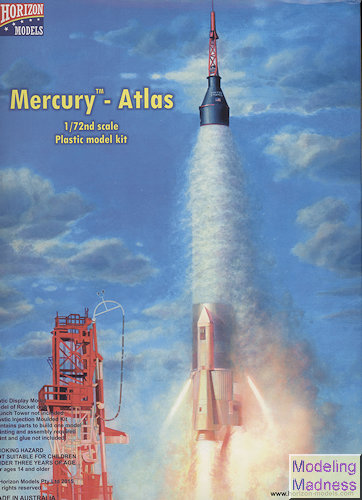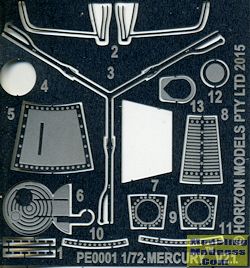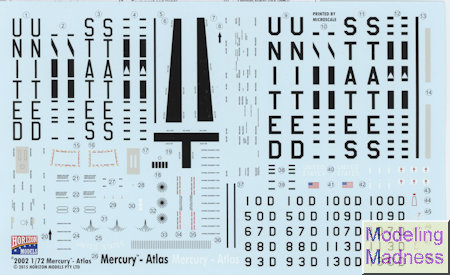
Horizon Models 1/72 Mercury-Atlas
| KIT #: | 2002 |
| PRICE: | $54.95 SRP |
| DECALS: | Four manned mission options plus |
| REVIEWER: | Scott Van Aken |
| NOTES: | Includes photo etch |

| HISTORY |
Project Mercury was the first human spaceflight program of the United States running from 1959 through 1963. An early highlight of the Space Race, its goal was to put a human into Earth orbit and return the person safely, ideally before the Soviet Union. Taken over from the U.S. Air Force by the newly created civilian space agency NASA, it spanned twenty unmanned developmental missions involving test animals, and successful missions completed by six of the seven Mercury astronauts.
The program took its name from the wing-footed, fleet god of travel in Roman mythology, and is estimated to have cost $1.73 billion (current prices) and to have involved the work of 2 million people. The astronauts were collectively known as the "Mercury Seven", and each spacecraft was given a name ending with a "7" by its pilot.
After a slow start riddled with humiliating mistakes, the Mercury Project gained popularity, its missions followed by millions on radio and TV around the world. Its success laid the groundwork for Project Gemini, which carried two astronauts in each capsule and perfected space docking maneuvers essential for lunar travel, and the subsequent Apollo Moon-landing program announced a few weeks after the first manned Mercury flight.
The initial flights using the Redstone rocket as a booster proved the viability of the Mercury spacecraft, but did not have the thrust to enable orbit to be obtained. For that, NASA decided to use a current ICBM as the main motive power and so the Atlas missile was chosen. The Atlas had a bit of a checkered career getting into service, and the Atlas D that was used required a number of safeguards that would not have been required on the standard ICBM. Besides, it was the only rocket in the US arsenel that could launch the Mercury into orbit so there wasn't much choice. Fortunately, all the Mercury-Atlas manned flights went without a hitch.
| THE KIT |
 Horizon models has taken a logical step in producing the Mercury-Atlas combination. They already had a superb Mercury capsule model and since Dragon has already produced a Mercury-Redstone, the Atlas was next. One thing that I noticed when opening the box is that the kit includes parts not used for this boxing. By that, I mean that you get several warheads for the Atlas, showing the Horizon Models intends to kit the Atlas by itself, something that I know both real space and military modelers will be looking forward to seeing.
Horizon models has taken a logical step in producing the Mercury-Atlas combination. They already had a superb Mercury capsule model and since Dragon has already produced a Mercury-Redstone, the Atlas was next. One thing that I noticed when opening the box is that the kit includes parts not used for this boxing. By that, I mean that you get several warheads for the Atlas, showing the Horizon Models intends to kit the Atlas by itself, something that I know both real space and military modelers will be looking forward to seeing.
The Mercury is on a single large sprue that includes not only a display stand but also the body of the 'boiler plate' version. Each capsule is built up around a central core section that mounts onto the heat shield. There are three 'fuselage' sections that are attached.
There is a launch tower made of three support pieces that are glued together and atop that is a five piece rocket pack that consists of two halves and three nozzles. A spike fits atop that.  There is a single casting retrorocket pack that fits to the underside of the heat shield. A nicely done photo etch fret is included that includes the wiring for the escape tower, the straps for the retro rocket, the round windows for the early Mercury launches, some capsule braces for the early launches, a nose cap for the orbital and re-entry versions. and other smaller bits. Note that the blank areas shown actually have parts on this boxing's fret for items that fit on the Atlas itself.
There is a single casting retrorocket pack that fits to the underside of the heat shield. A nicely done photo etch fret is included that includes the wiring for the escape tower, the straps for the retro rocket, the round windows for the early Mercury launches, some capsule braces for the early launches, a nose cap for the orbital and re-entry versions. and other smaller bits. Note that the blank areas shown actually have parts on this boxing's fret for items that fit on the Atlas itself.
The Atlas comes in two halves and one needs to open various holes in order to properly model the rocket. There are differences in the lower section depending on which mission you are modeling. You can model both the test or 'boiler plate' missions, the Enos the Chimp mission or any of the manned missions. The instructions provide detailed information on these so you need to make your choice early and pay attention during the build. All the mission names are provided. Note that there are also changes to the capsule as early missions had round windows and later ones had more trapezoidal windows. The kit also includes a nice base, something required for the Atlas due to a rather promin ent vent pipe that sticks below the main engine nozzles.
ent vent pipe that sticks below the main engine nozzles.
Instructions are nicely printed and are actually quite detailed. As mentioned all the differences between missions are annotated as well as any modifications required. Since the Atlas is festooned with data and warning markings, you'll find a rather large decal sheet. This sheet is superbly printed and includes all the markings you'll need. A very detailed placement and painting guide is part of the instructions. Note that some of the markings need to be installed prior to the installation of some of the long pipes on the outside of the Atlas.
| CONCLUSIONS |
If you are a real space modeler, this is a kit you really need to have in your collection. In fact, you really need four of them to duplicate the four Mercury-Atlas missions. The end result will be a very nice model and one that is fairly tall. I'm looking forward to seeing their military Atlas productions and we can hope this will sell well enough to encourage them to start on doing Gemini kits.
| REFERENCES |
https://en.wikipedia.org/wiki/Project_Mercury
January 2016
Copyright ModelingMadness.com Thanks to Horizon Models for the preview kit. You can get yours direct fromthis link. If you would like your product reviewed fairly and fairly quickly, please contactthe editor or see other details in the